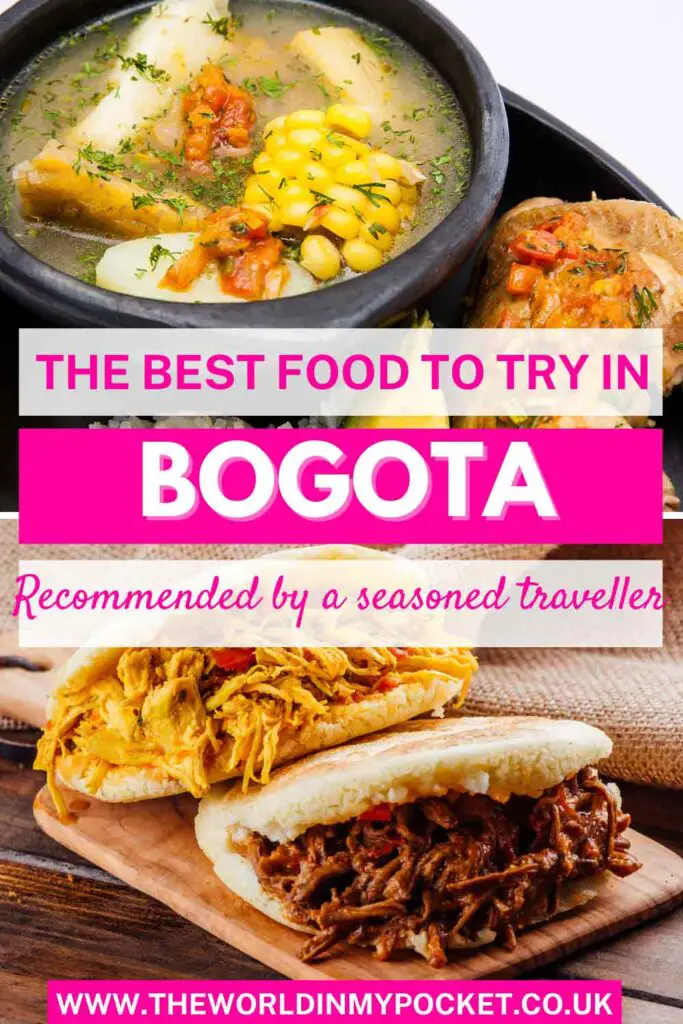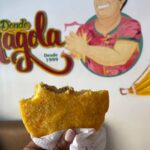The typical dishes in Bogotá, Colombia are full of flavor and tons of options. In this article I will tell you all about the best food in Bogota which you must try on your trip to this beautiful city.
Whether you love different cheese breads, are a fruit fanatic, or enjoy a hearty soup there is something for everyone to enjoy.
Just imagine waking up and walking around the corner from your apartment to buy freshly made bread and hot chocolate from the bakery, or panaderia, nearby. In Colombia, even hot chocolate is unique and extra delicious.
I’ve been to Bogotá several times and always try to eat all of my favorite dishes while I’m there. It’s one of my favorite travel destinations.
If you’re looking for a foodie guide to your typical dishes in Bogotá you simply have to try, then you’re in the right place.
Traditional Colombian Cuisine in Bogotá

The food and traditional dishes Bogotá, Colombia come from a mixture of a few different cultures.
It’s a mixture of the indigenous Colombian peoples with Spain and African influences. Recipes are passed down through the generations and Colombians take great pride in their delicious cuisine.
There is a heavy emphasis on food in Colombia whether it’s just a daily meal or a feast for a special event like a wedding.
Colombia is a country with so many different areas that all influence the dishes being served. The same soup in Bogota with chicken and pork might have fish instead in a coastal city.
What to Eat in Bogotá
Many dishes are hearty soups that go well with the colder, rainy weather in Bogotá. Platters of meat and potatoes with fried plantains are common to find in restaurants.
One of the best restaurants in Bogotá is Andres Carne de Res. It’s a fun interactive atmosphere with all of the traditional Colombian food options.
With street food, it’s common to see street stands selling arepas, empanadas, fruits, and obleas.
Wherever you decide to eat, you won’t be disappointed, the food in Bogota will surprise you with its delicious taste.
Ajiaco

Ajiaco is a traditional Colombian soup made with chicken, 3 kinds of potatoes, and a special herb called Guascas (Galinsoga parviflora). Believe me, it’s hard to get the right flavor in the soup if you don’t have Guascas.
This dish is often served in a black Chamba clay soup bowl and comes with a plate of rice, avocado, and corn on the cob. You are supposed to add as much of the rice and avocado as you wish. The corn on the cob is also best after adding to the soup.
A little tip: take the chicken out of the soup, cut it up on your plate, then put it back into the soup. My first time eating Ajiaco I didn’t know what to do with the large chunk of chicken still on the bone, floating in the broth.
Sancocho

Sancocho is another hearty soup, but this one is made with different types of meat.
Typically beef, pork, and chicken are found with potatoes, yuca, cilantro, and plantains. Just like ajiaco, you will be served with a plate of rice, avocado, and cord on the cob to add to the soup.
You’ll find variations of sancocho all over Latin America, but I think the version served in Bogota is the best.
Other variations include different proteins like fish or additional vegetables added to the soup.
Colombia is unique in adding plantain to Sancocho. In fact, fried plantain is often a side dish for many Colombian meals. Patacones are my favorite, fried green plantains with a nice crisp to them. The fried sweet plantains are also delicious with just a softer texture and sweeter taste.
Caldo de Costilla

One thing to know about Bogotá is the colder weather. It’s usually 15℃ with the potential to rain year-round.
Soups are a hearty meal perfect for chilly, rainy days. Caldo de Costilla is a beef rib soup with potatoes and cilantro. It’s traditionally made for breakfast.
Just because it looks plain compared to all the items piled into ajiaco and sancocho doesn’t mean it’s lacking in flavor. It’s one of my favorite dishes in Bogotá, Colombia.
Bandeja Paisa

Moving out of the soup category you’ll find a lot of meat-heavy dishes in Bogotá.
Bandeja Paisa is one of the best food in Bogotá you’ll find. This platter has a grilled steak with fried pork rinds and chorizo sausages. As if that wasn’t enough, you also have white rice, red beans, sunny-side-up eggs, and avocado. Oh, and don’t forget the fried plantains.
It is a full plate. Even if you’re hungry, I recommend splitting this one with a friend.
Lechona

Speaking of meat, lechona is an entire pig stuffed with rice, peas, and spices. It’s then cooked for several hours and served as a festive centerpiece, especially at parties and special events, making it one of the best food in Bogota.
I walked around a few different areas in Bogotá, and always saw a lechona among the shop stands along the streets or in the town squares.
Luckily, they often give out a sample for you to taste. Of course, it’s so good, I ended up buying a to-go box to take with me. The meat is so tender, full of flavor, and perfectly blended with the other ingredients.
Empanadas

Empanadas are fried pastries with different meat or cheese filling found in many Latin American countries. In Bogotá, they are filled with beef and potato- my favorite combination!
These pastries can vary in size and are often found as street food or served as an appetizer at restaurants.
Traditionally, you take a bite then add some aji and squirt a lime wedge on top. Aji is a salsa made with mild aji peppers, cilantro, garlic, and lime juice.
Colombian food is not spicy so the aji adds a nice kick of flavor. Typical aji is not very spicy, but you can make it with hotter peppers if you want to up the heat.
If you don’t like the aji, you don’t have to add it to your empanada. You should at least try squeezing a fresh lime wedge on your empanada as you eat it.
Tamales
Colombian tamales are huge, at least compared to the Mexican tamales I was used to before visiting Bogotá.
The tamales are made with arepamasa (pre-cooked corn meal) and filled with chicken and pork ribs, carrots, potatoes, and chickpeas. All of this is wrapped in banana leaves, tied up with butcher string, and then steamed.
The result is quite impressive, although you’ll be disappointed if you want a spicy tamal colombiano since they are not spicy like Mexican tamales.
I love to eat Colombian tamales for breakfast. Just learn from my mistake and be sure to watch out for bones from the chicken. If you eat it too fast you can easily overlook and bite down on one of those little bones.
Arepas

In Colombia, each region makes arepas differently and they are all delicious.
Arepas are basically a type of corn tortilla and are made from cornmeal. Just like in the Disney movie Encanto, a popular way to eat arepas is with cheese inside. This is called an arepa con queso.
In Bogotá, the arepas are flatter than in other areas. Just outside of Bogotá on the way to Villa de Leyva, you’ll find a thicker, puffier arepa.
Grill it, add some melted butter and salt, then enjoy!
A lot of restaurants serve arepas as a side dish or as an appetizer. I love to eat them with scrambled eggs for breakfast.
Pan de Yuca
If you love cheese bread, this one is for you. Pan de Yuca is a very popular breadstick made from yuca flour and cheese.
It’s a soft and chewy cheesy bread that has a light taste to it. Any panaderia in Bogotá will have pan de yuca freshly made.
Buy it with a cup of hot chocolate and enjoy!
Buñuelos
Buñuelos are another traditional Colombian cheese bread. Made as a sphere, the dough is denser than pan de yuca, and the bread itself tastes sweeter.
Make sure you have a napkin nearby. Buñuelos can be very crumbly to eat.
It’s such a great breakfast item to grab and go while walking around the city.
Pan de Bono
Had enough cheese bread yet? No? Good, because there’s more! Pan de Bono is another delicious food in Bogota.
Pan de Bono is made with cornmeal, cassava starch, cheese, and eggs.
It’s often made in a circle (kind of bagel shaped). The crisp outside and salty-sweet inside makes it similar to pan de yuca.
Lulada

Forget lemonade. Bogotá is usually on the chillier side of the weather, but when the sun does come out, it gets warmer.
There’s nothing more refreshing on a sunny day than lulada. It’s a drink made with the lulo fruit, lime juice, sugar, and water.
I bought a glass when wandering through the flea market in Bogotá, and it was so good!
The best part is the chunks of Lulo fruit you get in the juice. It has the texture of a tomato, but the sweet bitter taste of citrus. In English, this fruit is called “little orange.” It’s known in other countries as naranjita de quito.
Chocolate con Queso
OK, we’re back on cheese, but this time it’s not in bread- it’s in hot chocolate!
That’s right, in Colombia, they put cheese in hot chocolate.
A soft mozzarella cheese is melted by the heat of your hot chocolate. Once it’s melty enough go ahead and grab a spoon to eat the gooey yumminess.
Ask for chocolate caliente con queso, or simply chocolate santafereño, grab your fresh pan de yuca, and enjoy a wonderful morning at a cute cafe in Bogotá.
Obleas

One of the first desserts I had in Bogotá was an oblea.
Obleas are thin wafers spread with arequipe (caramel) sandwiched in the middle.
It’s a light, sweet, and delicious dessert. Many city courtyards in Bogota will have stands selling obleas.
You can also buy a tin of them at the grocery store to bring home with you. The wafers are stacked with a styrofoam cushion on the top and bottom. The arequipe container sits right on top.
Frutas

Fruits, or frutas, in Bogotá, are one of the highlights of any Colombian vacation.
They have such a huge variety, you have to pace yourself so you don’t eat too much fruit and wind up with digestion issues.
Here are some of my favorites:
- Maracuyá (passion fruit)
- Pitaya (dragon fruit)
- Uchuva (golden berry)
- Curuba (banana passion fruit)
- Lulo (“little orange”)
- Guanábana (soursop)
- Granadilla (related to passion fruit)
My friend called the granadilla fruit “booger fruit” because it looks like a mess of boogers.
Granadilla fruit has a juicy grape-like consistency and surrounds seeds you can just swallow. It is so sweet and easily one of my favorites, despite the odd look
Don’t forget to order fresh fruit juice and get ice cream in these amazing fruit flavors!
Conclusion
Colombia’s rich culture and history play a large role in generational recipes. Typical dishes in Bogotá Colombia vary from hearty soups to handheld empanadas.
You will absolutely love all of the fresh bread from bakeries everywhere in the city. The fruits are exotic and make amazing juices and ice cream flavors.
Wherever you travel in Colombia, don’t miss visiting the country’s capital and experiencing the amazing typical dishes in Bogotá.
Q&A:
What are some of the best restaurants in Bogotá to try local cuisine?
The best restaurant in Bogotá is Andrés Carne de Res, known for its steak and lively atmosphere. La Puerta Falsa is another good option since it’s one of the oldest restaurants in the city and famous for its tamales and hot chocolate. Crepe y Waffles has the best bread bowls and ice cream in Bogotá.
Where can I find the best street food in Bogotá?

You can find the best street food in Bogotá on almost every corner and square center. The best experience is the Plaza de Mercado de Paloquemao, one of the city’s largest markets. Enjoy empanadas, arepas, obleas, and fresh fruit.
Are there any vegetarian or vegan options in traditional Colombian food?
There are plenty of vegetarian and vegan options in Colombia even though most of the traditional dishes are meat-based. You can have ajiaco without the chicken, arepas, vegetable-based tamales, and vegetable-filled empanadas. Just make sure to get things without cheese if you need the vegan option.
Is Colombian food spicy?
Colombian food is not typically spicy. Traditional Colombian food uses herbs and spices for flavor, not heat. However, aji, a type of salsa, is often served on the side, so you can add as much or as little spice as you want. The spicy level of the aji depends on the types of peppers used to make it.
What is the traditional breakfast in Bogotá?

A very traditional breakfast in Bogotá is Caldo de Costilla, a beef rib soup, served with arepas, and Colombian coffee. If you like something a little lighter in the morning, it’s typical to eat pan de bono or pan de yuca, both types of cheese bread.
For more similar articles, check out my recommendations below:
Like it? Pin it!

Disclaimer: Some of the links on this website are “affiliate links.” This means that if you click on the link and do a purchase, I will receive an affiliate commission at no extra cost for you. This helps me keep my website running and continue to share my travelling knowledge with you. I thank you for booking your flights or hotels using the links on my website. Regardless, I only recommend products or services I use personally and believe will add value to my readers.

